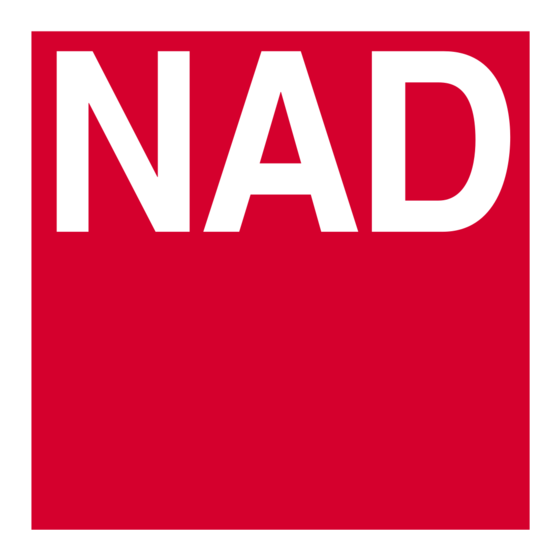Advertisement
Quick Links
3155 Integrated Amplifier
Date of manufacture : Jan 85 - Jan 87
Please note that this document contains the text from the original product brochure, and some technical statements may now be out of date
NAD leads the audio industry in producing amplifiers with high-headroom circuitry and high-current
output stages, precisely the qualities needed for musically accurate reproduction of today's wide-range
analogue and digital recordings. The 3155 integrated amplifier and the matching 2155 power amp are
the finest in a long tradition of highly praised NAD amplifiers, with increased power, improved reliability,
and numerous small refinements in both sound quality and ease of use.
The 3155 is two products in one. As a preamplifier it matches most separate audiophile preamps in
sonic performance and surpasses them in operating flexibility. As a high-current high-headroom power
amplifier it drives even "difficult" loudspeakers to surprisingly high volume levels with clean, solid, full-
bodied musical sound that remains refreshingly free from distortion even in transient peaks. The
combination of pre- and power amp, sharing one heavy-duty transformer and chassis, offers another
traditional NAD virtue: an impressive ratio of performance to price. The 2155, which is simply the power
amplifier section of the 3155 packaged on a separate chassis, is NAD's "building-block" amp, offering a
variety of convenient and economical approaches to upgrading a stereo system for higher performance
and power. The 2155 is an obvious choice if you want to step up from a low-powered receiver or
integrated amp, or if you are using a separate preamplifier. If you need still higher power, a pair of
2155s in the "bridged" mode deliver nearly three times as much power output for only twice the cost.
The 3155 and 2155 deliver substantially more than their conservatively rated 55 watts/channel into the
complex and varying impedances of real loudspeakers. In the bridged monophonic mode each amplifier
is rated conservatively at 150 watts continuous output. And these amplifiers maintain a full 3 dB of IHF
dynamic headroom (2.5 dB in bridged mode), meaning that they deliver twice their rated power in brief
bursts: over 110 watts/channel in stereo and about 250 watts in bridged configuration. This headroom
for peaks is crucially important for reproducing the uncompressed transients in modern digital and DBX-
encoded recordings.
When combined as a bridged stereo pair, the 3155 and 2155 function as a 150 W/ch stereo amplifier
with 250 watts per channel of short-term output. That power, together with the remarkable flexibility
and flawless sonic performance of the 3155's preamplifier section, makes the 3155/2155 combination a
remarkable best-buy system.
High Current and Headroom: Designing For Real-Use Conditions
Since amplifiers are usually rated in terms of a few standard specifications (e.g. 8-ohm power and THD),
many designers concentrate on optimising test-bench performance. But in the real world, amplifiers are
connected to loudspeakers with complex impedances, not to 8-ohm test resistors, and they are used to
play music, not sine-wave test tones. In NAD amplifiers every circuit is designed to deliver full
performance under real-use conditions. While many specific engineering goals follow from this principle,
two have been the cornerstones of every amplifier in NAD history (including the legendary Model 3020):
graceful handling of dynamic transients that exceed the amplifier's rated power, and the ability to deliver
large bursts of output current to the loudspeakers. Electrical power is the product of voltage and
current, but it is the current flowing through the voice coil that causes a loudspeaker cone to vibrate
and reproduce sound. As NAD engineers have always known, and other manufacturers have lately
begun to realise, to obtain precise electromagnetic control of the speaker's motion the amplifier must be
able to supply high peak currents upon demand, unconstricted by transistor "protection" circuits. The
NAD 3155/2155 amplifier circuit produces peak cur-rents of up to 40 amperes per channel.
Advertisement

Summary of Contents for NAD 3155
-
Page 1: Integrated Amplifier
DBX- encoded recordings. When combined as a bridged stereo pair, the 3155 and 2155 function as a 150 W/ch stereo amplifier with 250 watts per channel of short-term output. That power, together with the remarkable flexibility and flawless sonic performance of the 3155’s preamplifier section, makes the 3155/2155 combination a... -
Page 2: Product Features
Compact Discs. Ultra-quiet MM and MC phono preamp circuits. As long as LPs remain a principal music source, there must be no compromise in the phono preamp. The phono circuit in the NAD 3155 employs ten selected transistors per channel to obtain the widest possible dynamic range with outstanding freedom from noise and distortion at all signal levels. - Page 3 Exceptional Performance and Value The 3155 amplifier represents the kind of value that has made NAD world-famous. With its flexible and musically useful controls, its very low noise and wide dynamic range, its powerful high-current output stage, its unique speaker-impedance matching for maximum power transfer, its “building block”...
-
Page 4: Specifications
* Minimum power per chnnel, 20Hz - 20kHz, both channels driven with no more than rated distiortion. Dimensions are of unit’s cabinet without attached feet; add up to 18mm for total height. Dimension depth excludes terminals, sockets, controls and buttons. © NAD Electronics. All rights reserved. E & OE 47kΩ / 100/200/320pF 100Ω / 1000pF 2.8mV...














